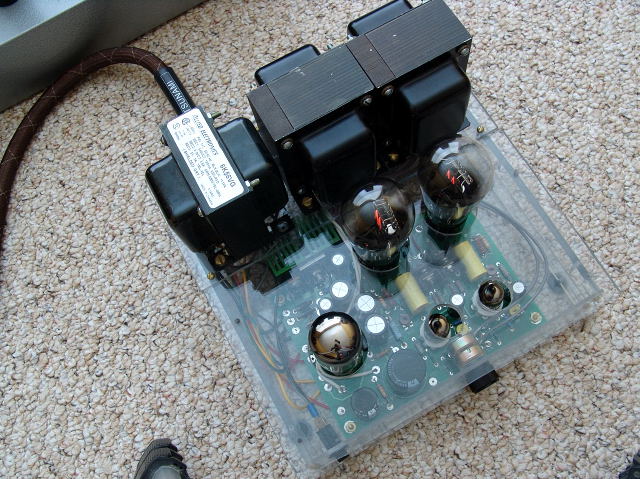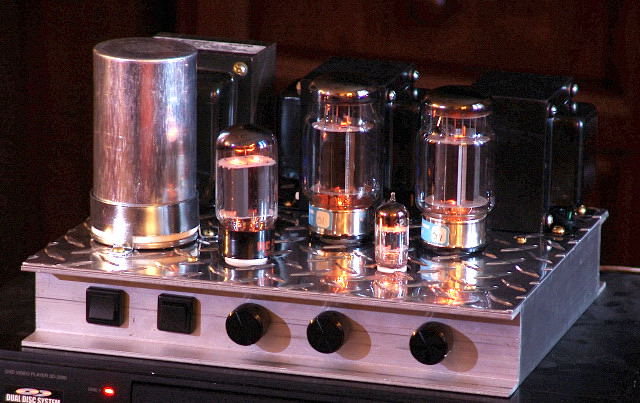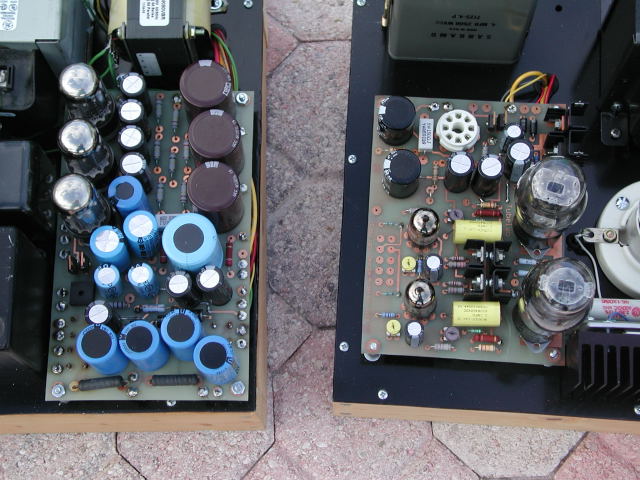The PC boards for our most popular designs will be explained on this page. Since the cost of commercial board fabrication is highly dependent on the quantity of boards ordered, only designs which generate considerable interest can be produced. Long term success of this web site is dependent on sales of these PC boards, parts, amplifiers, and possibly complete kits.
PC boards for tube amplifiers
It has been stated on several web sites that PC boards "kill the sound" or that only glass Teflon PC boards should be used. These myths probably began when PC boards were made from phenolic (definitely bad) and propagated by the fact that a poorly designed PC board can sound terrible due to the high impedances involved. In my full time job I design PC boards that routinely operate at frequencies above 1GHz. It is possible to design a PC board for a vacuum tube amplifier that will outperform a hand wired amplifier of similar design. That was proven out with the 300Beast driver board, and again with the SE amp designs. I have completed several amplifiers using the Tubelab SE amp board. Every one of them sound awesome. The performance is the same for each one whether it is mounted on an aluminum chassis or completely unshielded in a Lexan cabinet. As stated above, my PC board designs have been designed and tested to perform as good as (or often better) than a hand wired point to point design. All of the grounding issues have been worked out so that hum is already taken care of.
The Tubelab SE amp board is used for a "no compromises" amplifier that uses DHT tubes like the 45, 2A3 and 300B. It is used primarily for constructing a high end DHT amplifier. It is not uncommon for a user to spend $500 to $1000 USD for a complete amplifier, although it is possible to build an amplifier for lower cost. The Tubelab SE board was never intended to be a beginner's level project, in fact I didn't intend for it to be sold commercially at all when I designed the board. I have been using it to construct SE amplifiers for about 3 years. The output tubes operate in fixed bias, requiring measurements, and adjustments on a live board. The assembly manual, schematics, and theory of operation are all on this web site.
 A Tubelab SE board in a clear Lexan case.
A Tubelab SE board in a clear Lexan case.
The Tubelab SSE board is used to make a simplified SE amplifier that uses indirectly heated tubes like the 6L6GC, EL34, KT88 and 6550. This board is used to construct amplifiers from a basic low cost design to a high end triode mode amplifier. Most amplifiers are expected to cost between $250 and $700 USD, although you could spend less if you have some parts (transformers and tubes), and it is always possible to spend more in this hobby. The choice of output tubes are all pentodes, which can be operated in triode mode, Ultralinear, and Pentode mode. This can be switch selectable from the amplifiers front panel. The output tubes operate in cathode bias mode, requiring no adjustments. The PC board was designed to be assembled by people of all skill levels. The parts density is about half of the Tubelab SE. The assembly instructions are written with this in mind. There are photographs of every step from the start to final amplifier construction. More details are being added weekly.
 A Tubelab SSE board mounted under a piece of polished aluminum diamond plate.
A Tubelab SSE board mounted under a piece of polished aluminum diamond plate.
The 845 SE amp was designed using a Tubelab SE board as a driver. This requires an additional board, the PowerDrive board, and an external power supply which could be made using our 845 Power Supply board. Note that neither of these additional boards are available from us at this time.
Our Boards in Action ---- The 845SE Amplifier
 The Power Supply board is on the left, the SE amp board on the right.
The Power Supply board is on the left, the SE amp board on the right.
I have had several people e-mail me asking if I could make them a unique PC board, even a prototype board. Please understand that this is impossible at this time. Each person has asked for something unique, or a board for a tube that I have never tested. A new and unique PC board design and layout takes me 10 to 20 hours of work to generate the files for a simple board like the PowerDrive board, and 40 to 100 hours for a board like the Tubelab SE. A prototype quality (cooked up in my kitchen) board like the ones shown below takes me 4 hours or more. For a commercially oriented project like the Tubelab SE, I will typically design the board, build one and thoroughly test it, then refine the design and re do the PCboard. Then I repeat the testing cycle. The board is often refined for parts fitment, thermal management and performance criteria. The Tubelab SE went through three complete redesigns before I was satisfied with it. The Tubelab SSE went through two. It is not uncommon for a complex design (like a cell phone) to go through 10 or more board iterations before it is offered for sale. I simply do not have the time to pursue this for one off boards, nor would it be economically feasible.